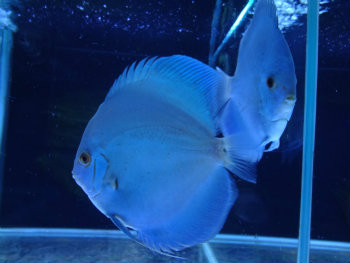 Loading... Please wait...
Loading... Please wait...- Home
- Discus
- Discus Breeding Pairs
- Blue Diamond Discus 15-16 cm Pair
Blue Diamond Discus 15-16 cm Pair
Product Description
Blue Diamond Discus variant was originally developed by breeders from Malaysia and Hong Kong who found that some Blue Turquoise Discus variant fry were transparent in color. When these transparent fry matured, their bodies were solid blue in color without any markings or patterns indicative of the Blue Turquoise on their body, gill covers or fins. Quality Blue Diamond Discus exhibit a solid blue body and red eyes, with some specimens exhibiting a slight yellow coloration on the caudal (tail) fin.
In the wild, this particular Discus variant stems from the species, whose scientific name is Symphysodon discus, and is found living in the upper tributaries of the Rio Negro and Rio Madiera along with the surrounding lakes and flood plains. The water is very low in mineral content, which makes it “soft” water with a low pH ranging from 5.5 to 6.5The water also maintains very stable and consistent water parameters year round, including water temperatures that range between 29-30c degrees Fahrenheit both during the day and night. When keeping this Discus variant in the home aquarium, it is extremely important to replicate these natural surroundings and water parameters as closely as possible. It is also very important to maintain very consistent water parameters that have very little pH, temperature and dissolved mineral fluctuations.
The Wild Discus, originated from the Amazon River Systems of South America, first imported into the aquarium hobby in the early 1930s. Ever since their introduction into the hobby to this day, the Discus genus,Symphysodon, are considered to be one of the most colorful, demanding, rewarding, and expensive of all tropical freshwater aquarium fish groups..
Any Discus should be fed a variety of nutritional meaty foods including: white worms, blood worms, Tubifex worms, high protein pellet and flake foods. Juvenile Discus should be fed at least 3 to 5 times per day, while adult specimens should be fed 2 times per day. Their overall diet needs to be higher in proteins and fats then the average tropical fish species. As with most other fish species, they need to be fed only the amount of food that they will consume within 10 minutes, with leftover foods removed from the system by a quality mechanical filter or manually if strong filtration is not present.



